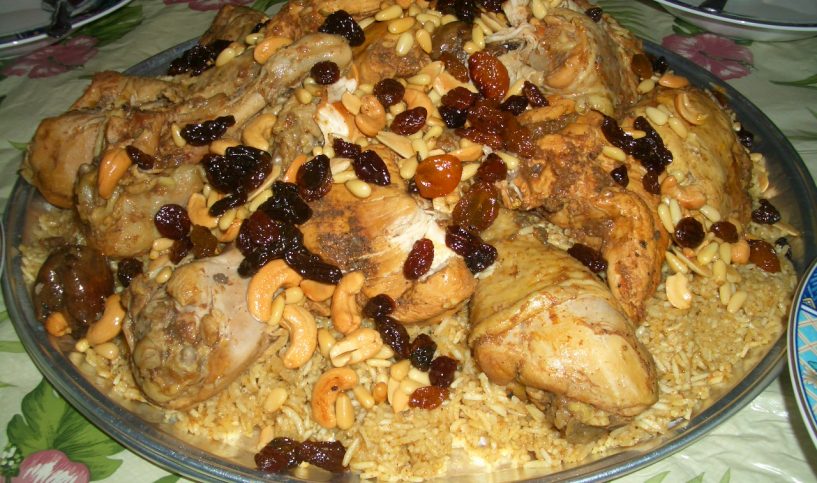By Meghan McCabe
What is Kuwaiti cuisine? I believe that people ask this question because until recently, there were less than a handful of Kuwaiti restaurants in the entire country. Most of the restaurants that you see here are Lebanese, so people assume that Kuwaiti food is of a Mediterranean nature. Where Mediterranean cuisine is light, Kuwaiti is more of the comfort-food variety: hearty meals with large portions of fish or meat and sauces. You won’t find nouveau cuisine portions at Kuwaiti restaurants. Comfort food comes in family/economy sizes, so pull up your sleeves and put on your most comfortable stretchy pants. Generosity is a pillar of Kuwaiti hospitality and that means bringing out the large trays when guests arrive.
Generally, all Kuwaiti restaurants will offer the same dishes (it would be similar to comparing menus at steak houses). What defines one restaurant from another is their use of spice (baharat); as the spices are key to completing the dish. For example, murubbian (shrimp with dill, peppers, and cilantro over rice) would not be good without just the right amount of seasonings: Fresh dill is a must. Without turmeric or saffron (or in some dishes, pistachios or dried cherries), rice can be bland and boring. There are many spice markets in Kuwait and I suspect that this is where McCormick™ shops; as spices here are sold by the kilo and/or sack-full. Kuwaiti mothers and grandmothers blend their own “secret” spices for unique tastes.
So, when you visit a Kuwaiti restaurant, you learn to compare how good the cuisine is by the spices used (and how fresh the fish, lamb, or chicken. Beef is rarely used). Your palate will eventually differentiate between sumac and dried lemon (for example). Both are bitter, but there are slight nuances. Sometimes, it is even possible to determine (perhaps after many years of eating Kuwaiti cuisine) where the chef is from and if he/she is trying to impersonate a Kuwaiti grandmother-chef. (At this point in my life, I am actually able to make that distinction; my waistline is my evidence.)
Types of Kuwaiti Cuisine, broken down (English spelling of translated names may differ; sometimes you will find funny spellings on menus like “lamp” for lamb.): Daqoos is a tomato sauce that accompanies rice dishes. It is made with tomatoes, salt, and garlic. Hareesa is similar to a ratatouille with chicken, meat, or shrimp, onions and peppers and accompanied by bread. Jarish (pronounced “yareesh” in Kuwaiti dialect as Kuwaitis turn “J” sounds to “Y”) is a thick oatmeal-based stew with meat broth and small pieces of lamb. Jarjeer is a form of watercress or rocket. Most meals will include jarjeer either in salad or alone. Logaymat are Kuwaiti-style donut holes. The best logaymat are crisp on the outside, lightly seasoned with saffron, coated in a sugar paste and with a very slight taste of lemon. Machboos is a dish cooked with either lamb or chicken (sometimes, although rarely, with camel), browned then baked, and served on a bed of yellow rice. Mowish is similar to murubbian, but with dried shrimp, shrimp, spices, and onion (sometimes green pepper) served on a bed of rice. It is more aromatic than murubbian. I prefer murubbian which is fresh fish, dill, cilantro, onion and green peppers. Mutabag is an accompaniment; a tomato-based stew and can be made with fish, chicken or lamb. Qabot is Kuwaiti-style dumplings: rolled dough around ground meat with raisins served in a tomato broth. Tashreeb: I love tashreeb. It is Kuwait’s lasagna and uses very thin flat bread in place of noodles, and a tomato lamb stew with vegetables and dried lemon. Tashreeb is the ultimate comfort food in Kuwait. Torshi is homemade pickles which accompany most meals.
(A note on biryani: Although you will find biryani on almost every menu in almost every Kuwaiti restaurant, biryani is an Indian dish so I haven’t included it above. A variation of biryani, Kuwaiti-style, which I have not come across in restaurants, is pouring a small amount of saffron-infused rosewater over the rice at completion for aroma.)
Fish is an entire section on its own. Hamoor (grouper) and zubaidy are the favorites in Kuwait. Sheem is my favorite; similar to a small bluefish with dark meat. Kuwait exports jumbo prawns; they thrive in the shallow waters in Kuwait at the tip of the Gulf. Seafood is cooked a variety of ways in Kuwait (although steaming is not common). Fish is either fried or grilled with hashu (stuffing consisting of dried lemon, cilantro, raisins, onions and spices). A true Kuwaiti fish meal will never neglect the accompaniment of tamarind fish sauce. Gub-gub (crabs), although plentiful and cheap in Kuwait, are not popular and great deals can be found at the fish markets. There are many seafood restaurants that are either carry-out or delivery only. Whole fish can be ordered to cook any way you like and several of these restaurants can be found online. Try the crabs from Fresh Grill or grilled shrimp or hareesa from Fresh Fish; both on 6alabat.com.
[A note on ingredients: Lamb: Most Kuwaitis will tell you that local lamb is better than imported; it is certainly much more aromatic. If you are really lucky, you might find camel on a menu – take the opportunity and try it. It tastes like a very lean beef – if you’ve been given a good piece, especially from the hump of a young camel. Rice: Always basmati. Vegetarian dishes: If you are a vegetarian, Kuwaiti cuisine is really not for you. If you ask for “no meat”, they will just remove it (meaning that the stew may have been cooked with lamb). However, there are several very good vegetarian restaurants in Kuwait and you can always find veg dishes in Indian restaurants.]
Fresh fruit juice can be found everywhere in Kuwait: You can find just about every possible type of fruit juice here, from moz-halib (banana and milk) to shammam (mellon), to layered cocktail juice with banana, strawberry and mango stripes. Try a samadi (mango juice with fresh pieces of fruit) or an embratoor (similar to a samadi with ice cream). If you don’t like too much sugar; let them know as it is added generously.
Tea in Kuwait has different variations of seasonings like saffron, cardamom and mint. Loomi tea is dried lemon (and great for colds).
Kuwaiti restaurants and décor: There seems to have been a cultural revival going on during the past five to seven years in the restaurant industry in Kuwait. Most of the Kuwaiti cuisine restaurant-owners have honored their ancestry and heritage by decorating their venues to depict a former traditional Kuwaiti way of life; many even showcasing photos of their family members from years ago. It seems to be almost a statement on social life and values, as the country has modernized so quickly. Even fifteen years ago, most Kuwaiti families didn’t dine in restaurants and today, many modern families don’t eat (or have the time for) home-cooked meals. Perhaps the owners are creating interactive mini-museums, nostalgic of a previous existence not so long ago. Almost all of the Kuwaiti-cuisine restaurants still maintain the tradition of “family” sections and “singles” (male) sections. Many offer “cabinas” or private dining rooms – most often to make the veiled ladies more comfortable while dining. So now, an introduction to Kuwaiti restaurants (in alphabetical order):
Al Boom restaurant in the Radisson Blu hotel is of Kuwait’s oldest landmarks and the only restaurant in Kuwait which is housed in an authentic Kuwaiti boom (sailing ship). It is a truly unique dining experience and anyone visiting Kuwait should really take the opportunity to visit it. Walls of the boom are decorated in teak with inlays of brass. The restaurant specializes in seafood and always has a fresh and interesting salad buffet bar. Coffee is served on an upper level and guests can get a view of the surrounding waters from visiting the top deck of the ship. Fresh bread is baked in an outdoor oven at the entrance, enticing hungry customers to venture inside.
Alwatani Kitchen has locations in downtown Kuwait, Hawalli and Abu Halifa and can be ordered online. Those who don’t like a lot of spice in their food will enjoy the meals from Alwantani.
Beit Dixon Restaurant (although spelled slightly differently) is the namesake of the historic residence of Dame Violet Dickson and British Colonial Administrator, Harold Dickson. The Dicksons were beloved by the Kuwaiti people, having spent most of their lives in Kuwait. Beit Dixon’s décor is traditional Kuwaiti; decorated to replicate old Kuwaiti living. The walls are reflective of the mud walls used in housing; there are wood beams with old/traditional food storage baskets hanging from them, and artwork which depicts Kuwait’s history.
(Note on the word “Freej”: Many Kuwaiti restaurants are prefaced with the name “Freej”. Freej is an old Gulf term for “neighborhood”.)
Freej Bin Shamlan has one of the nicest home-delivery packages I’ve ever come across – and even includes a traditional plastic table (ok, floor, as many people sit on the floor to eat) covering. Sometimes it is the extras that set a restaurant apart from the competition. Their food was well seasoned and fresh.
Freej Suwaileh is on Salem Al-Mubarak Street in Salmiya. The décor is a replica of a Kuwaiti village with items that depict Kuwait’s history and heritage. They say you can tell how authentic a local cuisine restaurant is by the number of locals who dine there. Freej Suwaileh is packed on the weekends, especially on a Friday after prayer services. They serve a sample portion of logaymat as soon as guests are seated which is a nice touch and always makes you want to order more at the end of the meal.
Freej Eqaab is located in Dajeej off 6th Ring Road. Similar to other freej’s, it is decorated to replicate old Kuwaiti living. Freej Eqaab is my pick for an inexpensive menu, offering items at prices lower than other restaurants I’ve listed.
Maadenaa Restaurant is the most elegant Kuwaiti restaurant in town. Perched on the 28th floor of the Jasem Tower in downtown Kuwait, the restaurant offers a 360 degree view of Kuwait and the Gulf. Maadenaa serves an updated Kuwaiti cuisine and also offers Morroccan food on the menu. There is no traditional ambiance at Maadenaa; furniture and décor is modern.
Muhallab at the Palms is a traditional Kuwaiti seafood restaurant that offers all-inclusive pricing on meals. For example, if you order a whole nagroor (fish), the meal includes (for the table) mezza (assortment of cold salads), freshly baked bread, fresh fruit basket, tea and deserts. Muhallab’s seafood is consistently high quality as is their service. As a bonus, the restaurant is beach-front, overlooking the Hashemi boom next door and the gulf waters. It is a weekend lunchtime “must-do” especially if you are entertaining out of town visitors.
The oldest Kuwaiti restaurant in the country is Shatea Alwatyia restaurant in the Behbehani Homes complex in downtown Kuwait behind the Sheraton. Unlike many Kuwaiti restaurants that have followed, Shatea Alwatyia is located in an original old Kuwaiti-style family home, built in the 1950’s. The Behbehani houses are the few remaining remnants of Kuwait’s (not-so-distant in Western terms) past; now lost to concrete and glass. Many current Kuwaiti restaurants have tried to replicate the ambiance of yesteryear whereas Shatea Alwatyia’s ambiance is original. If you are interested in seeing how Kuwaiti families used to live, in rooms surrounding an atrium and courtyard supported by original wood beams, Shatea Alwatyia is the place to go. The restaurant began with a Kuwaiti grandmother in the kitchen. She has managed to retain her legacy through several chefs who have retained the consistency of quality Kuwaiti food.
Setinat is located in Hawalli on Beirut Street and offers the most tender lamb I’ve had at any restaurant. Like it’s freej cousins, Setinat is also decorated in old Kuwaiti traditional style.
Sandwich shops are everywhere in Kuwait and all you have to do is pull up to one and honk your horn and you’ll get immediate service. If you are looking for a shawarma (similar to a gyro) try Nowara with locations downtown and Salem Al-Mubarak Street in Salmiya. Doo restaurant in Salmiya has the best falafel anywhere – try it with mint. Caporia serves wonderful grilled shrimp sandwiches. You’ll find many sandwich shops for a quick-fix on Shaar Al-Mata’em (Restaurants Street) in Salmiya.
You would be remiss (as a resident or a visitor) if you left the country without ever having experienced a meal at Souq Mubarakia in downtown Kuwait. Mubarakia is the oldest and largest traditional Kuwaiti souq. It is home to numerous small restaurants that specialize in seafood, grills and other delicious items. The restaurants are mostly open-air and the best time to visit is in cooler months in the evening. Sample great Kuwaiti food, then take a walk down numerous off-shoot alleys that sell gold, spice, Bedouin weavings, and a variety of miscellaneous merchandise within the souq.
(A note about delivery: Most of the aforementioned restaurants deliver. Many are listed on talabat.com.)















